Tschuwaschien |
|
|
|
| Übersicht – Contents: | |
Diese Seite ist Teil des Projektes
Tschuwaschien |
|
|
|
| Übersicht – Contents: | |
Flagge – Flag: |
|
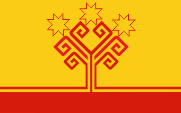 |
Nationalflagge – national flag, |
historische Flaggen – historical Flags: |
|
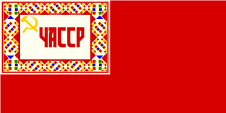 |
1927–1931, Flagge der Tschuwaschischen Autonomen Sozialistischen Sowjetrepublik – flag of the Chuvash Autonomous Soviet Socialist Republic, Seitenverhältnis – ratio = 1:2, Quelle/Source, nach/by: World Statesmen |
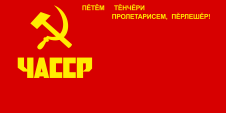 |
1931–1938, Flagge der Tschuwaschischen Autonomen Sozialistischen Sowjetrepublik – flag of the Chuvash Autonomous Soviet Socialist Republic, Seitenverhältnis – ratio = 1:2, Quelle/Source, nach/by: World Statesmen |
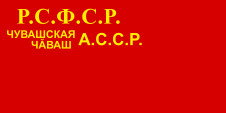 |
1938–1954, Flagge der Tschuwaschischen Autonomen Sozialistischen Sowjetrepublik – flag of the Chuvash Autonomous Soviet Socialist Republic, Seitenverhältnis – ratio = 1:2, Quelle/Source, nach/by: World Statesmen |
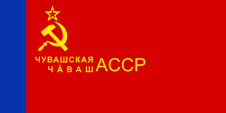 |
1954–1978, Flagge der Tschuwaschischen Autonomen Sozialistischen Sowjetrepublik – flag of the Chuvash Autonomous Soviet Socialist Republic, Seitenverhältnis – ratio = 1:2, Quelle/Source, nach/by: World Statesmen |
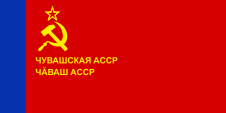 |
1978–1992, Flagge der Tschuwaschischen Autonomen Sozialistischen Sowjetrepublik – flag of the Chuvash Autonomous Soviet Socialist Republic, Seitenverhältnis – ratio = 1:2, Quelle/Source, nach/by: World Statesmen |
|
siehe auch – look also: Flaggengeschichte der Sowjetrepubliken der UdSSR – flag history of the soviet republics of the USSR |
|
Bedeutung/Ursprung der Flagge – Meaning/Origin of the Flag: |
|
| Die Flagge Tschuwaschiens wurde am 29.04.1992 eingeführt und zeigt im Prinzip zwei waagerechte Streifen in Gold und Rot. Der breite goldene Streifen zeigt in der Mitte einen stilisierten Baum, ein Symbol für die Wiedergeburt, über dem Baum drei traditionell gestaltete Sonnensymbole. Rot steht für das Land, Gold für deine Bodenschätze. | The flag
of Chuvashia was introduced on 29th of April in 1992 and shows in principle
two horizontal stripes in gold and red. The broad golden stripe shows in the middle a stylized tree, a symbol for the rebirth, above the tree three traditional styled sun symbols. Red stands for the country, gold for its mineral resources. |
| Die Flaggen, die zu Sowjet-Zeiten verwendet wurden, entsprachen alle dem immer gleichen Schema, wie es für Sowjetische Autonome Republiken vorgesehen war: Zwischen 1923 und 1937 oft nur ein einfabiges rotes Flaggentuch mit einer goldenen Inschrift, die den Landesnamen zeigte. Manchmal nur als Abkürzung, manchmal mit vollem Namen, manchmal nur in Russisch oder auch mehrsprachig. Ab etwa 1937 wurden manchmal noch Hammer, Sichel und Stern ergänzt. Ab etwa der Mitte der 50-er Jahre wurden mehrfarbige Flaggen für die Republiken der Sowjetunion eingeführt, deren Strickmuster die untergeordneten Autonomen Sowjetrepubliken zu übernehmen hatten. |
The flags, which were used in the Soviet era corresponded all to the same
pattern as it was intended for the Soviet Autonomous Republics:
Between 1923 and 1937 frequently only a single-coloured red bunting with a golden inscription, showing the name of the country. Sometimes only as a shortcut, sometimes the full name, sometimes only in Russian or even multilingual. From about 1937 hammer, sickle and star were sometimes added. From about the mid-50s multicolored flags were introduced for the republics of the Soviet Union, whose knitting patterns had to be taken over by the subordinated autonomous Soviet republics. |
| Quelle/Source: Flaggen Enzyklopädie, Volker Preuß | |
Wappen – Coat of Arms: |
|
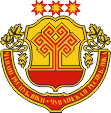 |
Wappen der Republik Tschuwaschien – coat of arms of the Republic of Chuvashia, Quelle/Source: Russiatrek |
Bedeutung/Ursprung des Wappens – Meaning/Origin of the Coat of Arms: |
|
| Das Wappen Tschuwaschiens zeigt das Bild der Flagge, den Baum, links und rechts flankiert von Blättern und Früchten, oberhalb des Schildes drei traditionell gestaltete Sonnensymbole. Im Spruchband der Name des Landes in Tschuwaschisch und Russisch. | The coat of arms of Chuvashia shows the image of the flag, the tree, to the left and on the right flanked by leafs and fruits, above the shield three traditional styled sun symbols. In the banner the name of the country in Chuvashian and Russian. |
| Quelle/Source: Flaggen Enzyklopädie, Volker Preuß | |
Landkarten – Maps: |
geographische Lage in Russland – geographical position within Russia: |
Landkarte des Landes – map of the country: |
Zahlen und Fakten – Numbers and Facts: |
|
|
|
|
|
|
|
|
|
|
|
|
|
|
|
|
|
|
|
|
Geschichte: |
|
frühes Mittelalter · Herausbildung der Tschuwaschen als
finnougrisches Volk 7. Jahrhundert · Eroberung und Unterwerfung durch die Wolgabulgaren, Turkisierung 1237 · Mongoleneinfall, Zerstörung des Bulgarenreiches, Tschuwaschien kommt zum Reich der Goldenen Horde 1420 · Zerfall des Reiches der Goldenen Horde in mehrere einzelne Khanate, Tschuwaschien kommt zum Khanat Kasan 1584 · das Khanat Kasan wird von Russland erobert, Christianisierung 1769 · Einführung der Tschuwaschischen Schriftsprache mit kyrillischem Alphabet 1919 · Errichtung der Sowjetdiktatur 24.06.1920 · Errichtung des "Autonomen Kreises der Tschuwaschen" 21.04.1925 · Errichtung der "Tschuwaschischen Autonomen Sozialistischen Sowjetrepublik" 24.10.1990 · Tschuwaschien erklärt seine Souveränität 31.12.1991 · die Sowjetunion löst sich auf, die Verfassung der Russischen Sozialistischen Föderativen Sowjetrepublik (RSFSR, Russland), ein ehemaliger Teilstaat der Sowjetunion bleibt vorerst in Kraft 31.03.1992 · neue Verfassung als Republik Tschuwaschien, Ende der Sowjetmacht 25.12.1993 · eine neue Verfassung für Russland (Russische Föderation) tritt in Kraft, das Verhältnis zu den Gliedern der Föderation wird damit neu geregelt |
History: |
|
early middle ages · evolution of the Chuvash as a finnougrian
people 7th century · conquest and subjection by the Volga Bulgars, Turkization 1237 · Invasion of the Mongols, destruction of the Bulgar's Empire, Chuvashia comes to the Empire of the Golden Horde 1420 · disintegration of the Empire of the Golden Horde in several particular Khanates, Chuvashia comes to the Khanate of Kasan 1584 · the Khanate of Kasan gets conquered by Russia, Christianization 1769 · introduction of the Chuvash writing diction with cyrillic alphabet 1919 · establishment of the soviet dictatorship 24.06.1920 · establishment of the "Autonomous District of the Chuvash" 21.04.1925 · establishment of the "Chuvash Autonomous Socialistic Soviet Republic" 24.10.1990 · Chuvashia declares its sovereignty 31st of December in 1991 · the Soviet Union dissolves, the constitution of the Russian Socialist Federative Soviet Republic (RSFSR, Russia), a former substate of the Soviet Union, remains in force for the time being 31.03.1992 · new constitution as Republic of Chuvashia, end of the Soviet power 25th of December in 1993 · a new constitution for Russia (Russian Federation) comes into force, and the relationships with the members of the federation is re-regulated in this way |
| Quelle/Source: Atlas zur Geschichte, World Statesmen, Russiatrek, Die Völker der Erde |
Ursprung des Landesnamens – Origin of the Country's Name: |
|
| "Tschuwaschien" ist natürlich das Land der Tschuwaschen, ein turkisiertes finnougrisches Volk, das sich selber "Tschawasch" nennt. | "Chuvashia" is of course the country of the Chuvash, a turkizated finnougrian people, which calls itself "Chavash". |
| Quelle/Source: Die Völker der Erde | |